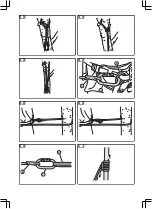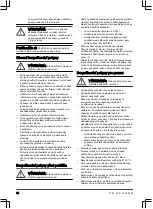
• Do a check of the structure that the product is
attached to. Make sure that the structure has
sufficient strength for the operation, including the
additional load that an emergency situation can
cause.
• The product can be used as a belay for the rescuer
after a single fall. Select an applicable tree, branch
or other structural anchor that is resistant to a
minimum of 12 kN.
• Make sure that the length of the product is sufficient
for the object that it is looped around. Refer to
operate the product as an anchor device on page
6
.
• Prevent rope slack between the anchor point and the
operator. Always keep the work positioning system
in tension.
• If the product is used in fall arrest applications, the
potential fall distance must not be more than 500
mm.
• If the product is subject to a fall, take it out of service
immediately. Refer to
.
Operation
Introduction
WARNING:
Read and understand the
safety chapter before you use the product.
To operate the product as an anchor
device
The product complies with EN 795B, standard for
anchor devices.
• Put the product around a support structure, such as
a branch, in one of these configurations:
a) As a choke sling. (Fig. 3)
b) As a single sling. (Fig. 4)
c) As a double sling. (Fig. 5)
• Make sure that the selected configuration is
applicable for the load on the product. Refer to
Breaking loads in different configurations on page
6
.
Breaking loads in different configurations
The breaking load of the product depends on the
selected configuration and the diameter of the support
structure. Refer to the table below for breaking loads
measured under laboratory conditions.
WARNING:
The values in the table are
for reference only since the diameter of the
support structure has a major impact on the
result.
Configura-
tion
Support structure
type and diameter
Breaking load
Choke sling Bolt, 34 mm diam-
eter
Rope breakage at
35 kN
Single sling
Drum, 250 mm di-
ameter
Rope breakage at
20 kN
Double sling Drum, 250 mm di-
ameter
Carabiner break-
age at 40 kN
Applicable usage as a lanyard
The product complies with EN 354:2010, standard for
lanyards.
When used as a lanyard, the product has 3 different
approved areas of use:
• Around a support structure or attached to an anchor
device in a work positioning system: The product is
used to keep the operator in a position where the
operator can use both hands.
• Around a support structure or attached to an anchor
device in a restraint system: The product prevents
the operator from reaching places where there is a
risk of falling down.
• In a fall arrest system, as described in the standard
EN 363: The product catches the operator if they fall.
Refer to
To use the product in a fall arrest system on
page 7
.
For all 3 areas of use, the total length of the product and
other connected components must not be more than 2.0
m.
For usage around a support structure in a work
positioning system or a restraint system, refer to
the product around a support structure on page 6
.
For all lanyard usages you must know how to select
an anchor device or anchor point correctly. Refer to
select an anchor device or anchor point on page 7
.
To use the product around a support structure
The product is applicable for use in work positioning
systems and restraint systems as described in the
standard EN 358.
1. Attach the eye end connection of the product (A) to a
suspension eye (B) on the harness with a carabiner
(C). (Fig. 6)
2. If you use the product around a support structure,
attach the other end in one of these configurations:
a) With a carabiner in a suspension eye on the
harness and the ring end connection on the
product. (Fig. 7)
6
1781 - 003 - 13.06.2022
Содержание Multi Sling
Страница 3: ...3 4 5 A C B 6 7 8 B C A 9 10 ...
Страница 139: ...1781 003 13 06 2022 139 ...






























